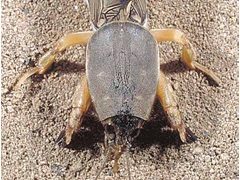
Mole crickets are highly specialized insects adapted for burrowing through soils. Some species prey on other insects and small invertebrates and other mole crickets feed on plants, primarily their roots. All species damage turf as they burrow just under the turf surface which separates turf roots from soil particles.
This can cause the roots to dry rapidly, and lose their ability to take up water and nutrients. This results in crown and top dieback. Mole cricket damage often appears as trails of yellowing and wilting turf, general thinning, soil pushed up in small 3-5 cm mounds, or trails of sand or soil where the turf is thin or absent.
Mole crickets can be extremely damaging to highly maintained golf course tees and putting greens. Adult and near-adult mole crickets can dig through the dense roots of these surfaces or walk onto these surfaces under the cover of night where they dig in at random. Because of the dense surfaces, they literally have to tear the turf apart in order to dig in. This results in damage that must be repaired immediately before play resumes.
Life Cycles
Mole crickets have what is called an incomplete life cycle. This means that the adult females lay eggs that hatch into nymphs that look like miniature adults except they have no wings and are not able to reproduce.
Newly hatched nymphs are only about 6 to 8 mm long but they can still dig through lose soil. For this reason, most of the eggs are laid near water habitats and in turf that is less dense (fairways and roughs) but regularly irrigated. These nymphs feed very close to the soil surface and are quite susceptible to surface insecticide applications. The nymphs develop quite rapidly, under-going several molts (shedding of their exoskeletons). When they are about half mature (2.0 to 2.5 cm), they are much more prone to dig deeper into the soils and by this time, summer heat and drought conditions can drive them 0.5 to 2.0 m into the soil. After rains or irrigation, the mole crickets will return to the surface to feed but when the soil dries or extreme heat occurs, they will rapidly move deep into their burrows.
If conditions are favourable (moist soils and plentiful food), many mole crickets will reach adulthood by late fall (6 to 8 months after egg hatch). However, some species don't reach adulthood until early the next spring and in unfavourable conditions, the mole crickets may even take two years to complete development.
In moderate temperate zones, cool fall conditions cause most insects, including mole crickets, to become inactive. The adults or near-adult nymphs dig deep into the soil and wait until warmer conditions. In tropical and sub-tropical zones all stages can be found year round though most species time their egg laying with the beginning of the spring or early summer rainy seasons.
